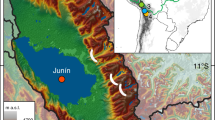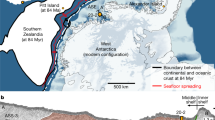Abstract
Investigating the processes that led to the end of the last interglacial period is relevant for understanding how our ongoing interglacial will end, which has been a matter of much debate (see, for example, refs 1, 2). A recent ice core from Greenland demonstrates climate cooling from 122,000 years ago3 driven by orbitally controlled insolation, with glacial inception at 118,000 years ago4,5,6,7,8. Here we present an annually resolved, layer-counted record of varve thickness, quartz grain size and pollen assemblages from a maar lake in the Eifel (Germany), which documents a late Eemian aridity pulse lasting 468 years with dust storms, aridity, bushfire and a decline of thermophilous trees at the time of glacial inception. We interpret the decrease in both precipitation and temperature as an indication of a close link of this extreme climate event to a sudden southward shift of the position of the North Atlantic drift, the ocean current that brings warm surface waters to the northern European region. The late Eemian aridity pulse occurred at a 65° N July insolation of 416 W m-2, close to today's value of 428 W m-2 (ref. 9), and may therefore be relevant for the interpretation of present-day climate variability.
This is a preview of subscription content, access via your institution
Access options
Subscribe to this journal
Receive 51 print issues and online access
$199.00 per year
only $3.90 per issue
Buy this article
- Purchase on Springer Link
- Instant access to full article PDF
Prices may be subject to local taxes which are calculated during checkout




Similar content being viewed by others
References
Kukla, G. J. & Went, E. Start of a Glacial (Springer, Berlin, 1992)
Kukla, G., McManus, J. F., Rousseau, D.-D. & Chuine, I. How long and how stable was the last Interglacial? Quat. Sci. Rev. 16, 605–612 (1997)
NorthGrip, High resolution record of Northern Hemisphere climate extending into the last interglacial period. Nature 43, 147–151 (2004)
Khodri, M. et al. Simulating the amplification of orbital forcing by ocean feedbacks in the last glaciation. Nature 410, 570–574 (2001)
Berger, A. & Loutre, M. F. An exceptionally long interglacial ahead? Science 297, 1287–1288 (2002)
Calov, R., Ganopolski, A., Claussen, M., Petukhov, V. & Greve, R. Transient simulation of the last glacial inception. Part I: Glacial inception as a bifurcation in the climate system. Climate Dyn. 24,doi:10.1007/s00382-005-0007-6 (2005)
Lambeck, K. & Chappell, J. Sea level change through the last glacial cycle. Science 292, 679–685 (2001)
Sánchez-Goñi, M. F. et al. Synchroneity between marine and terrestrial responses to millennial scale climatic variability during the last glacial period in the mediterranean region. Climate Dyn. 19, 95–105 (2002)
Berger, A. & Loutre, M. F. Insolation values for the climate of the last 10 million years. Quat. Sci. Rev. 10, 297–317 (1991)
Bond, G. & Lotti, R. Iceberg discharges into the North Atlantic on millennial time scales during the last glaciation. Science 267, 1005–1010 (1995)
Thouveny, N. et al. Climate variations in Europe over the past 140 kyr deduced from rock magnetism. Nature 371, 503–506 (1994)
Allen, J. R. M. et al. Rapid environmental changes in southern Europe during the last glacial period. Nature 400, 740–743 (1999)
Lehman, S. J., Sachs, J. P., Rotwell, A. M., Keigwin, L. D. & Boyle, E. A. Relation of subtropical Atlantic temperature, high-latitude ice rafting, deep water formation, and European climate 130,000–60,000 years ago. Quat. Sci. Rev. 21, 1917–1924 (2002)
Müller, U. C. & Kukla, G. J. North Atlantic Current and European environments during the declining stage of the last interglacial. Geology 32, 1009–1012 (2004)
Van Kreveld, S. et al. Potential links between surging ice sheets, circulation changes, and the Daansgaard–Oeschger cycles in the Irminger Sea, 60–18 kyr. Paleoceanography 15, 425–442 (2000)
McManus, J. F. et al. High resolution climate records from the North Atlantic during the last interglacial. Nature 371, 326–329 (1994)
Chapman, M. R. & Shackleton, N. J. Global ice-volume fluctuations, North Atlantic ice-rafting events, and deep-ocean circulation changes between 130 and 70 ka. Geology 27, 795–798 (1999)
Müller, H. Pollenanalytische Untersuchungen und Jahresschichtenzählungen an der eem-zeitlichen Kieselgur von Bispingen/Luhe. Geol. Jb. A 21, 149–169 (1974)
Holzkämper, S., Mangini, A., Spötl, C. & Mudelsee, M. Timing and progression of the Last Interglacial derived from a high alpine stalagmite. Geophys. Res. Lett. 31, L07201 (doi:10.1029/2003GL019112) (2004)
Kühl, N. & Litt, T. Quantitative time series reconstruction of Eemian temperature at three European sites using pollen data. Veget. Hist. Archaeobot. 12, 205–214 (2003)
Büchel, G. Vulkanologische Karte der West- und Hocheifel, Map 1:50,000 (Institut für Geowissenschaften, Universität Mainz, 1994)
Larsen, C. P. S. et al. Relations between lake morphometry and the presence of laminated lake sediments: a re-examination of Larsen and MacDonald (1993). Quat. Sci. Rev. 17, 711–717 (1998)
Seelos, K. & Sirocko, F. RADIUS—rapid particle analysis of digital images by ultra-high resolution scanning of thin sections. Sedimentology 52, 669–681 (2005)
de Beaulieu, J. L. & Reille, M. Long Pleistocene pollen sequences from the Velay Plateau (Massif Central, France). Veget. Hist. Archaeobot. 1, 233–242 (1992)
Menke, B. & Tynni, R. Das Eeminterglazial und das Weichselfrühglazial von Rederstall/Dithmarschen und ihre Bedeutung für die mitteleuropäische Jungpleistozän-Gliederung. Geol. Jb. A 76, 3–120 (1984)
Woillard, G. Abrupt end of the last interglacial s.s. in north-east France. Nature 281, 558–565 (1979)
Björck, S. et al. Eemian lake development, hydrology and climate: a multi-stratigraphic study of the Hollerup site in Denmark. Quat. Sci. Rev. 19, 509–536 (2000)
Voelker, A. H. L. Global distribution of centennial-scale records for Marine Isotope Stage (MIS) 3: a database. Quat. Sci. Rev. 21, 1185–1212 (2001)
Erfurt, G., Krbetschek, M. R., Bortolot, V. J. & Preusser, F. A fully automated multi-spectral radioluminescence reading system for geochronometry and dosimetry. Nucl. Instrum. Methods Phys. Res. B 207, 487–499 (2003)
van den Bogaard, P., Hall, C. M., Schmincke, H.-U. & York, D. Precise single-grain 40Ar/39Ar dating of a cold to warm climate transition in Central Europe. Nature 342, 523–525 (1989)
Acknowledgements
Drilling of the ELSA cores was done by Stölben GmbH (www.stoelbenbohr.de), and we thank J. Schmitz for his continuous effort to increase the quality of the core material. We thank the Stiftung Rheinland-Pfalz für Innovation, which initiated the first ELSA drillings, and the DEKLIM program of the German Ministry for Education and Research, which financed ELSA over the past 5 years.Author Contributions K. Seelos, grain size analysis; K. Schaber, tuning; B.R., varve counting; F.D. and M.D., pollen analysis; K.J., varve classification; M.K. and D.D., luminescence dating.
Author information
Authors and Affiliations
Corresponding author
Ethics declarations
Competing interests
Reprints and permissions information is available at npg.nature.com/reprintsandpermissions. The authors declare no competing financial interests.
Supplementary information
Supplementary Figure S1
Photos of ELSA core HL2 (56 – 55m depth) from the dry maar lake west of Hoher List. (PDF 3627 kb)
Supplementary Figure S2
Pollen spectra. (PDF 2188 kb)
Rights and permissions
About this article
Cite this article
Sirocko, F., Seelos, K., Schaber, K. et al. A late Eemian aridity pulse in central Europe during the last glacial inception. Nature 436, 833–836 (2005). https://doi.org/10.1038/nature03905
Received:
Accepted:
Issue Date:
DOI: https://doi.org/10.1038/nature03905
This article is cited by
-
The response of the hydrological cycle to temperature changes in recent and distant climatic history
Progress in Earth and Planetary Science (2022)
-
Thresholds for the presence of glacial megafauna in central Europe during the last 60,000 years
Scientific Reports (2022)
-
Muted multidecadal climate variability in central Europe during cold stadial periods
Nature Geoscience (2021)
-
Abrupt high-latitude climate events and decoupled seasonal trends during the Eemian
Nature Communications (2018)
-
Atlantic deep water circulation during the last interglacial
Scientific Reports (2018)
Comments
By submitting a comment you agree to abide by our Terms and Community Guidelines. If you find something abusive or that does not comply with our terms or guidelines please flag it as inappropriate.



